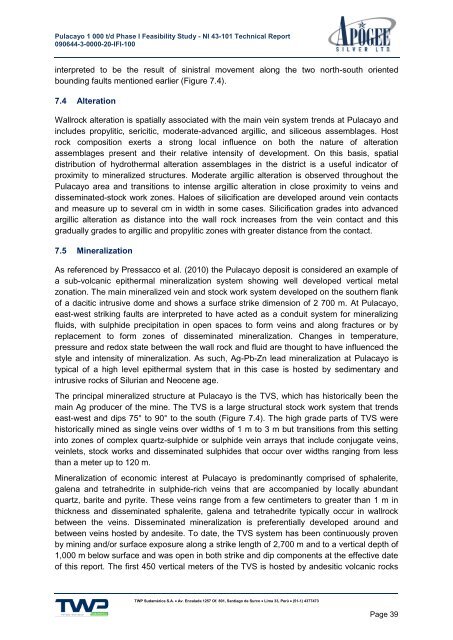Pulacayo Project Feasibility Study - Apogee Silver
Pulacayo Project Feasibility Study - Apogee Silver
Pulacayo Project Feasibility Study - Apogee Silver
Create successful ePaper yourself
Turn your PDF publications into a flip-book with our unique Google optimized e-Paper software.
<strong>Pulacayo</strong> 1 000 t/d Phase I <strong>Feasibility</strong> <strong>Study</strong> - NI 43-101 Technical Report<br />
090644-3-0000-20-IFI-100<br />
interpreted to be the result of sinistral movement along the two north-south oriented<br />
bounding faults mentioned earlier (Figure 7.4).<br />
7.4 Alteration<br />
Wallrock alteration is spatially associated with the main vein system trends at <strong>Pulacayo</strong> and<br />
includes propylitic, sericitic, moderate-advanced argillic, and siliceous assemblages. Host<br />
rock composition exerts a strong local influence on both the nature of alteration<br />
assemblages present and their relative intensity of development. On this basis, spatial<br />
distribution of hydrothermal alteration assemblages in the district is a useful indicator of<br />
proximity to mineralized structures. Moderate argillic alteration is observed throughout the<br />
<strong>Pulacayo</strong> area and transitions to intense argillic alteration in close proximity to veins and<br />
disseminated-stock work zones. Haloes of silicification are developed around vein contacts<br />
and measure up to several cm in width in some cases. Silicification grades into advanced<br />
argillic alteration as distance into the wall rock increases from the vein contact and this<br />
gradually grades to argillic and propylitic zones with greater distance from the contact.<br />
7.5 Mineralization<br />
As referenced by Pressacco et al. (2010) the <strong>Pulacayo</strong> deposit is considered an example of<br />
a sub-volcanic epithermal mineralization system showing well developed vertical metal<br />
zonation. The main mineralized vein and stock work system developed on the southern flank<br />
of a dacitic intrusive dome and shows a surface strike dimension of 2 700 m. At <strong>Pulacayo</strong>,<br />
east-west striking faults are interpreted to have acted as a conduit system for mineralizing<br />
fluids, with sulphide precipitation in open spaces to form veins and along fractures or by<br />
replacement to form zones of disseminated mineralization. Changes in temperature,<br />
pressure and redox state between the wall rock and fluid are thought to have influenced the<br />
style and intensity of mineralization. As such, Ag-Pb-Zn lead mineralization at <strong>Pulacayo</strong> is<br />
typical of a high level epithermal system that in this case is hosted by sedimentary and<br />
intrusive rocks of Silurian and Neocene age.<br />
The principal mineralized structure at <strong>Pulacayo</strong> is the TVS, which has historically been the<br />
main Ag producer of the mine. The TVS is a large structural stock work system that trends<br />
east-west and dips 75° to 90° to the south (Figure 7.4). The high grade parts of TVS were<br />
historically mined as single veins over widths of 1 m to 3 m but transitions from this setting<br />
into zones of complex quartz-sulphide or sulphide vein arrays that include conjugate veins,<br />
veinlets, stock works and disseminated sulphides that occur over widths ranging from less<br />
than a meter up to 120 m.<br />
Mineralization of economic interest at <strong>Pulacayo</strong> is predominantly comprised of sphalerite,<br />
galena and tetrahedrite in sulphide-rich veins that are accompanied by locally abundant<br />
quartz, barite and pyrite. These veins range from a few centimeters to greater than 1 m in<br />
thickness and disseminated sphalerite, galena and tetrahedrite typically occur in wallrock<br />
between the veins. Disseminated mineralization is preferentially developed around and<br />
between veins hosted by andesite. To date, the TVS system has been continuously proven<br />
by mining and/or surface exposure along a strike length of 2,700 m and to a vertical depth of<br />
1,000 m below surface and was open in both strike and dip components at the effective date<br />
of this report. The first 450 vertical meters of the TVS is hosted by andesitic volcanic rocks<br />
TWP Sudamérica S.A. Av. Encalada 1257 Of. 801, Santiago de Surco Lima 33, Perú (51-1) 4377473<br />
Page 39



